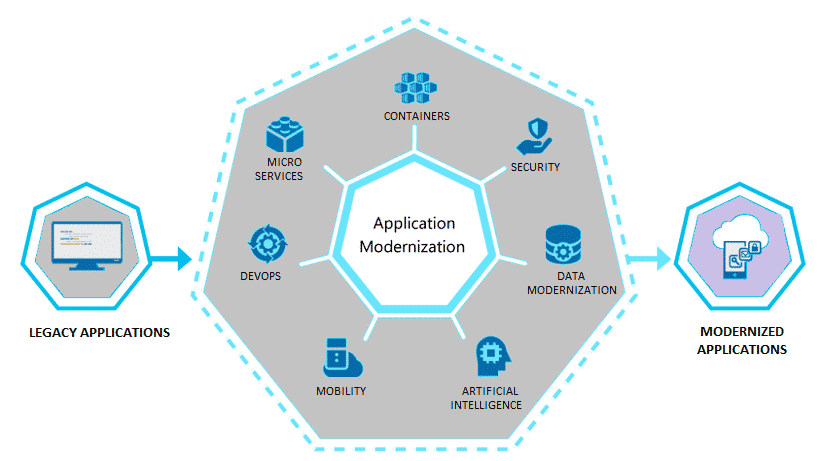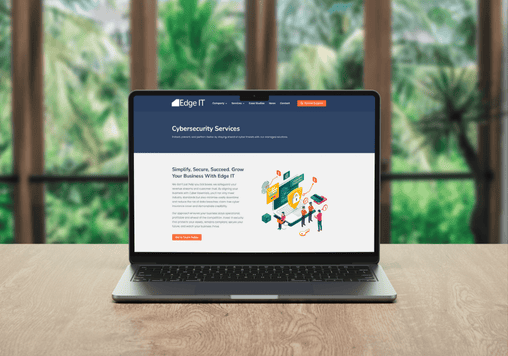Everyone has their favourite set of tools – those software products on which we have come to rely to conduct our day-to-day work and run our businesses. But, there comes a time at some point where those applications are deemed to be ‘knocking on a bit’, and have either been superseded with newer or alternative versions, or cease to exist entirely as the developer drops the platform or has ceased trading.
In some cases, however, you may feel that you have no choice to move forward – the world of technology keeps driving ahead, but you literally have no way of advancing from the application or database on which your entire business is built.
Continuing to rely on the same applications beyond the point at which they have deemed to be ‘end of life’ can be limiting, or potentially dangerous, to your business.
So, what approach can you take to ‘fix’ or modernise forward from or with your legacy applications?
In this article we’re going to explore the world of ‘legacy’ applications, the pitfalls, the options and the way ahead.
What are legacy applications?
As defined by Gartner, a legacy application is “an information system that may be based on outdated technologies, but is critical to day-to-day operations.”
Essentially, the term ‘legacy’ in computing is commonly used to refer to old technology; an older computer system, application, or IT infrastructure that is still in use and serves a purpose, but is generally regarded to have been superseded.
However, a system deemed to be legacy might not always be because of age or the quality of the supporting technology stack. The software that has been operating with minimal issue for years is still able to cope with its daily demands, so many argue, “why fix what ain’t broke?”.
There are a number of scenarios in which applications may arise as legacy within your organisation, these include…
When the operating system vendor ceases support
Operating systems, and the software programs that are built to work on that specific operating system version, are a great example of such legacy applications. Despite perhaps the software application itself remaining current, it’s a possibility that the operating system, or infrastructure the application is hosted upon, will not remain within support.
Upon the announcement that Microsoft were to mark their Server 2008 operating system as end of life, and therefore cease support and updates, countless businesses were thrown into uncertainty over the path ahead – how would they continue to, securely and compliantly, use their core line of business applications?
When the business has opted to not upgrade
Another incredibly common example is where a business has chosen not to update the application to the latest version. Industry-specific CRM / ERP systems, or perhaps common bookkeeping software such as Sage, can undergo frequent and sometimes costly updates. If a business chooses to not keep pace with those software updates, it can find itself unknowingly using what is now deemed to be a legacy version of the app.
The business may then become trapped – force to buy new IT equipment and operating systems to replace old, or as they expand; bringing with it newer operating systems that do not support the aged application they have failed to upgrade.
When there is simply no newer version available
As previously mentioned, it is sometimes a fact of life that a software vendor may cease to exist – or a very useful software application becomes dropped from their product portfolio, despite that application continuing to function and provide invaluable functionality to the business.
Without that continued support of the vendor, how will the application continue to function and move forward as newer computer and server operating systems get released?
The potential for legacy applications existing within your business is vast – whether intentionally or unintentionally so, you may feel stuck with applications that present you with a number of IT headaches. You have no option, but to map out a plan to move your business forward.
How are legacy applications holding back your business?
If you are continuing to use applications that are now deemed to be legacy, they clearly must be important to your business operations. Their continued use in their current entirely legacy capacity, however, presents a number of potentially broad challenges both operationally and technically.
Operational challenges
- Lack of current practices
The world moves on – compliance regulations change, operational practices evolve and the ways in which we work continually improve. Legacy applications are stuck in the past. With a lack of updates, comes a lack of current best practices and an increased risk of process deviation, convoluted manual workarounds and error.
- Lack of common knowledge
It is inevitable that the intricate knowledge and experience held within your business, surrounding the support and use of said legacy applications, will age-out. As younger staff join the business that are unfamiliar with older forms of technology, you carry the risk of being stuck without the expertise at-hand to support the legacy apps continued use.
- Lack of support
Legacy systems are often no longer supported and therefore do not benefit from vendor updates, which would normally fix stability issues, bugs and security vulnerabilities in the system. Without this ongoing protection, you can begin to suffer from a user experience that is inefficient, unstable, and (most worryingly) open to cyber breach – resulting in inconvenient downtime and costly financial or reputational loss.
❌ Lack of integration
With data and process automation being pivotal to efficient operations in modern business, legacy applications will lack the feature (entirely or almost entirely) of integration with other line of business applications or databases you use. Leaving you stuck with very manually driven processes.
❌ Lack of compliance
Sustaining compliance to a raft of legal obligations becomes an almost impossibility. GDPR regulations, among others, stipulate current supported software must be used where the storing and processing of personally identifiable information is concerned. Should your business have, or be looking to adopt, the UK Government’s Cyber Essentials programme, you will struggle to maintain compliance with its security obligations, should sensitive data be held in unsupported apps.
❌ Lack of remote access
In an age where home working is no longer a luxury, but a necessity; providing access to legacy applications for remote users is often possible, but can be difficult, often costly and does not make for a good user experience.
Technical challenges
❌ Lack of infrastructure support
As mentioned in the introduction, the IT infrastructure on which your legacy applications are hosted can leave you feeling trapped. Through hardware failure, operating system end of life, or simply at a time when you need more IT assets; it is inevitable your IT infrastructure will need to be renewed, likely leaving you ‘between a rock and hard place’ – with apps that are vital to your operations, but with IT that simply can’t run them.
❌ Lack of security
With a lack of ongoing support comes a lack of cybersecurity patches and defences. Your inability to defend against evolving cyber threats puts your data and the business overall at incredible risk.
❌ Lack of backup
Your ability to effectively backup and restore data, and to maintain continuity of operations in the event of a technical issue, could be impeded by your legacy applications.
How do I move forward with my legacy applications?
There are a variety of reasons why you may wish or simply need to move on from your current legacy applications. Whether cost, knowledge, compliance or operational efficiency are at stake, you have identified that the status quo with your legacy applications need to change.
There are three distinct options available to you that allow your business to digitally transform and overcome the aforementioned limitations.
Upgrade
What might seem the easiest answer – upgrading to the latest version of your current software, or replacing the software entirely and migrating to an alternative; is not always the easiest to implement.
Provided your application still exists, has a recently updated version and is still within support of the vendor, you may well decide to migrate to the most current version. This step-forward may well allow you to overcome most, but unlikely all of the challenges previously mentioned. Such an upgrade will inevitably come with software renewal costs, and depending on the version leap, (the jump in version numbers between your current application and the latest), may require technical expertise, and therefore incur additional costs, to implement.
There are a two key points that we strongly advise you to clear up when walking through this process with your software vendor, which will help your decision making process and to identify any implications on your IT at large:
- What is the future upgrade path of the software and what are the costs to keep current? – To ensure you are not left behind again, it would be advantageous to appreciate the work and costs involved with keeping up-to-date.
- What system requirements does the latest software have? – Should the system requirements outweigh your current IT infrastructure, you will incur costs to bring that up to speed.
Source an alternative application
You may well prefer to source an alternative application entirely. This procurement process is of course not without its own unique challenges, which we won’t explore within this article, however the two key points raised in the previous section are relevant here too.
Host them in the cloud
Some legacy applications are still considered critical to day-to-day operations in a business, despite there being more recent and supported versions of the software available to transition to. This can be for a variety of different reasons; the business may not have a dedicated IT specialist to educate management/ staff on the benefits of potentially using one of the different options, or it could be as simple as the team knowing the system and worrying about potential problems caused by – what they view as – an unnecessary change.
Whether you opt to upgrade or replace, source an alternative, choose to remain with or are stuck at your current version; hosting your legacy applications within the cloud will allow you overcome the growing operational and technical hurdles that you face.
Hosting your apps within the cloud, whether legacy or not, can bring your business the best of both world.
How to migrate your legacy application to the cloud
As opposed to continuing to host applications and databases upon your own servers and IT infrastructure, which are relatively static in terms of operating system version and hardware age, you could host them within the cloud.
Microsoft Azure is one example of a powerful, comprehensive and secure, yet cost effective, alternative means to hosting and supporting a wide variety of IT infrastructure requirements, including legacy applications.
How can I host my legacy apps that are not supported on current operating systems?
To address the restrictive status of some applications requiring outdated operation system versions, hosting the app within the cloud provides greater scope for backwards compatibility. Microsoft Azure will support the outdated hosting requirements of many legacy apps, by providing an emulated operating system environment – secure and compliant, layered on top of an up-to-date operating system host.
For example, your business relies upon an aged version of ERP software, which is no longer supported and will not function on server operating systems newer than Windows 2008. No problem, Microsoft Azure will support the backwards compatibility by providing an emulated Windows 2008 environment layered above the latest Windows server operating system.

The advantages of hosting legacy apps within the cloud
✔️ Integration
Integration with other systems is far more feasible on web-based applications. Web-based systems are considerably more interoperable than localised software due to localised software being more isolated.
✔️ Flexibility and scalability
As we previously mentioned, with what is going on in the world right now – and the uncertainty surrounding practically everything – it is essential to have software that is flexible and can deal with fluctuations in trade practically overnight. These are uncertain times, so knowing your apps can handle the rapid changes will be a big weight lifted off your shoulders.
✔️ Access
One of the key features of web-based apps is access – they allow for access from any computer or device with an internet connection. Most desktop software can be developed into web-based apps to make them accessible from any mobile device, promoting flexible working which, in turn, increases your employee’s’ overall levels of productivity, connectivity, and ability to collaborate.
✔️ Maintenance
A key feature mentioned when deploying web-based software is just how easy it is to adopt across the business. Maintenance is possible through one central point, meaning when there is an upgrade it can be done through one server (the host) instead of having to upgrade each machine individually. The system updates consistently across machines allowing for less downtime whilst waiting for the upgrade to install.
Web-based applications are making our new modern way of working possible and have been the unsung hero of the pandemic to businesses all over the globe. Our workdays have been different to what we are used to over the last year and some will never look the same again. It is web-based applications making this possible through flexible working, which in turn is allowing businesses not only to survive but thrive during the pandemic and beyond.
Supporting you to achieve your digital transformation goals
The team at Edge IT have years of experience in delivering cutting-edge technology services to fast-growing dynamic small businesses. The insights that we have gained from supporting businesses akin to your own are invaluable in aiding you to achieve your goals by successfully driving transformation through the best application of technology services.
If you are considering a migration to the cloud, evaluating Microsoft Azure or need to get better control from the cloud environment you already we have – we can help.
Please contact our team today for a free no obligation discovery call to explore your requirements.
¹ https://www.gartner.com/it-glossary/legacy-application-or-system/
Edge IT Can Help
Edge IT Can Help
Technology should empower your business, not hold it back. We provide proactive IT support, robust cybersecurity, and seamless solutions to keep your organisation secure and running smoothly. Get in touch today and let’s strengthen your IT for a smarter, safer future.
Edge IT Can Help
Technology should empower your business, not hold it back. We provide proactive IT support, robust cybersecurity, and seamless solutions to keep your organisation secure and running smoothly.
Get in touch today and let’s strengthen your IT for a smarter, safer future.


